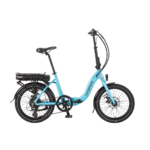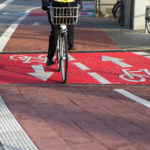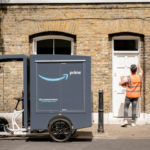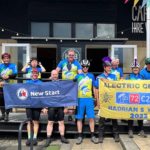Pedelec sensors
- Thread starter Pete
- Start date
True pedelec sensors are not torque sensors so they don't measure the pressure. Most use a disc with a ring of magnets inserted in it, mounted on the pedal shaft. A Hall sensor alongside picks up the pass rate of the magnets which enables the controller to sense if any pedalling is present and also set a maximum pulse rate if wanted to limit power assist to a set road speed in top gear.
Here's a poor photo of a pedelec ring and sensor under a bottom bracket and behind the chainwheel:

I don't know the Alien one, but it's probably the same method.
.
Here's a poor photo of a pedelec ring and sensor under a bottom bracket and behind the chainwheel:

I don't know the Alien one, but it's probably the same method.
.
Can understand that, but
Specifications for bikes routinely say the more pressure the greater the assist. Does this really mean then that it assumes a faster pedal rate means more assist? That can't be right as otherwise you would not get any help up a hill as your pedalling rate slows, but of course you do get more help, so what am I missing?
Specifications for bikes routinely say the more pressure the greater the assist. Does this really mean then that it assumes a faster pedal rate means more assist? That can't be right as otherwise you would not get any help up a hill as your pedalling rate slows, but of course you do get more help, so what am I missing?
Only for bikes using that system, many don't use it.Specifications for bikes routinely say the more pressure the greater the assist.
Your missing gears by the sound of it.Does this really mean then that it assumes a faster pedal rate means more assist? That can't be right as otherwise you would not get any help up a hill as your pedalling rate slows, but of course you do get more help, so what am I missing?
Any system that has a torque sensor to control the power reacts to pedal pressure. Most notably the crank drive unit's like the Panasonic, new Yamaha unit and Sunstar unit have these as standard, but some hub motor bikes have them too, either as standard or as an optional extra.
In some cases these can be strain gauges incorporated at the bottom bracket and in one case with a new Giant model, a pressure sensor is placed in the right hand rear frame dropout so that minute movements of the rear wheel spindle can be detected.
.
In some cases these can be strain gauges incorporated at the bottom bracket and in one case with a new Giant model, a pressure sensor is placed in the right hand rear frame dropout so that minute movements of the rear wheel spindle can be detected.
.
Thanks Flecc. What set me wondering was actually an posting by you on the forum where you explained the apparent illogical position that you got more power to help your hill climb if you effectively slowed down so you were getting full assistance rather that one of the stepped down levels. I think I have that right. This would mean a slow pedalling rate which conflicts with the answers above, or seems to to me.
Pete
Pete
That was about the Panasonic unit Pete, a part of their design in accordance with Japanese law. That law only allows full power up to 15 kph / 9.4 mph, the power phasing down below that. Since a chain drive motor has to be limited in top gear to that, it also affects the cadence, i.e. only a cadence corresponding to less than 9.5 mph giving full power. On the Panasonic unit that cadence is a lowly 39, everything above that giving reducing power.
A slow pedalling rate doesn't conflict since the maximum power exerted on a pedal will be at a slow rate, the faster the spin the less time there is to exert force. The Panasonic unit applies the power to each pedal stroke individually so the torque sensor pressure on each stroke determines the power you get. That power is determined in two ways therefore, by cadence and pedal pressure.
Full story here.
.
A slow pedalling rate doesn't conflict since the maximum power exerted on a pedal will be at a slow rate, the faster the spin the less time there is to exert force. The Panasonic unit applies the power to each pedal stroke individually so the torque sensor pressure on each stroke determines the power you get. That power is determined in two ways therefore, by cadence and pedal pressure.
Full story here.
.
Last edited:
Related Articles
-
 MTF Enterprises announces acquisition of EMU Electric Bikes
MTF Enterprises announces acquisition of EMU Electric Bikes- Started by: Pedelecs
-
 Wisper 806T folding bike wins Which? ‘Best Buy’
Wisper 806T folding bike wins Which? ‘Best Buy’- Started by: Pedelecs
-
 Sustrans calls for protected cycle lanes
Sustrans calls for protected cycle lanes- Started by: Pedelecs
-
 Amazon launch their first UK e-cargo micromobility hub
Amazon launch their first UK e-cargo micromobility hub- Started by: Pedelecs


